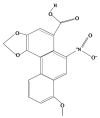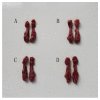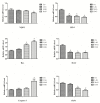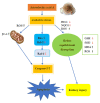Acute and Subchronic Toxicity Studies of Aristolochic Acid A in Tianfu Broilers
- PMID: 34071750
- PMCID: PMC8228413
- DOI: 10.3390/ani11061556
Acute and Subchronic Toxicity Studies of Aristolochic Acid A in Tianfu Broilers
Abstract
Aristolochic acid (AA) is one of the components of some traditional Chinese medicines, which has high toxic potential in animals, leading to huge economic losses in the breeding industry. The purpose of this study is to evaluate the toxicology of AA on Tianfu broilers through acute and subchronic toxicity tests. The results showed that the median lethal dose of AA to Tianfu broilers was 14.52 mg/kg. After continuous intraperitoneal injection of AA solution (1.452 mg/kg) for 28 days, the swollen and necrotic renal tubular epithelial cells were histologically observed; in addition, blood urea nitrogen (BUN) and creatinine (Cre) were significantly increased, indicating AA could induce serious kidney lesions in broilers. Moreover, the ROS, the apoptosis rate and the depolarization rate of the mitochondrial membrane potential of broilers' renal cells increased. The results of QRT-PCR showed that AA reduced the mRNA expressions of HO-1, NQO1, Raf-1 and Bcl-2, while the expressions of Bax and Caspase-3 increased, which show that AA aroused oxidative stress and promoted the apoptosis of renal cells. In conclusion, AA has been found to damage broilers' kidneys by breaking the redox balance to form oxidative stress, along with promoting apoptosis of renal cells.
Keywords: Tianfu broiler; aristolochic acid; kidney; oxidative stress; subchronic toxicity.
Conflict of interest statement
The authors declare no conflict of interest.
Figures









Similar articles
-
Aristolochic Acid I-Induced Hepatotoxicity in Tianfu Broilers Is Associated with Oxidative-Stress-Mediated Apoptosis and Mitochondrial Damage.Animals (Basel). 2021 Dec 2;11(12):3437. doi: 10.3390/ani11123437. Animals (Basel). 2021. PMID: 34944214 Free PMC article.
-
The protective role of Nrf2 against aristolochic acid-induced renal tubular epithelial cell injury.Toxicol Mech Methods. 2020 Oct;30(8):580-589. doi: 10.1080/15376516.2020.1795765. Epub 2020 Aug 4. Toxicol Mech Methods. 2020. PMID: 32660364
-
Florfenicol causes excessive lipid peroxidation and apoptosis induced renal injury in broilers.Ecotoxicol Environ Saf. 2021 Jan 1;207:111282. doi: 10.1016/j.ecoenv.2020.111282. Epub 2020 Sep 16. Ecotoxicol Environ Saf. 2021. PMID: 32949928
-
Autophagy induction promotes aristolochic acid-I-induced renal injury in vivo and in vitro.Toxicology. 2013 Oct 4;312:63-73. doi: 10.1016/j.tox.2013.07.017. Epub 2013 Aug 11. Toxicology. 2013. PMID: 23939141
-
Melatonin Attenuates Mitochondrial Damage in Aristolochic Acid-Induced Acute Kidney Injury.Biomol Ther (Seoul). 2023 Jan 1;31(1):97-107. doi: 10.4062/biomolther.2022.054. Epub 2022 Sep 13. Biomol Ther (Seoul). 2023. PMID: 36097885 Free PMC article.
Cited by
-
Aristolochic Acid I-Induced Hepatotoxicity in Tianfu Broilers Is Associated with Oxidative-Stress-Mediated Apoptosis and Mitochondrial Damage.Animals (Basel). 2021 Dec 2;11(12):3437. doi: 10.3390/ani11123437. Animals (Basel). 2021. PMID: 34944214 Free PMC article.
References
-
- Ng A.W.T., Poon S.L., Huang M.N., Lim J.Q., Boot A., Yu W., Suzuki Y., Thangaraju S., Ng C.C.Y., Tan P., et al. Aristolochic acids and their derivatives are widely implicated in liver cancers in Taiwan and throughout Asia. Sci. Transl. Med. 2017;9:6446. doi: 10.1126/scitranslmed.aan6446. - DOI - PubMed
-
- Schmeiser H.H., Bieler C.A., Wiessler M., van Ypersele de Strihou C., Cosyns J.P. Detection of DNA adducts formed by aristolochic acid in renal tissue from patients with Chinese herbs nephropathy. Cancer Res. 1996;56:2025. - PubMed
-
- Wu T.-K., Wei C.-W., Pan Y.-R., Cherng S.-H., Chang W.-J., Wang H.-F., Yu Y.-L. Vitamin C attenuates the toxic effect of aristolochic acid on renal tubular cells via decreasing oxidative stress-mediated cell death pathways. Mol. Med. Rep. 2015;12:6086–6092. doi: 10.3892/mmr.2015.4167. - DOI - PubMed
Grants and funding
LinkOut - more resources
Full Text Sources
Research Materials
Miscellaneous

